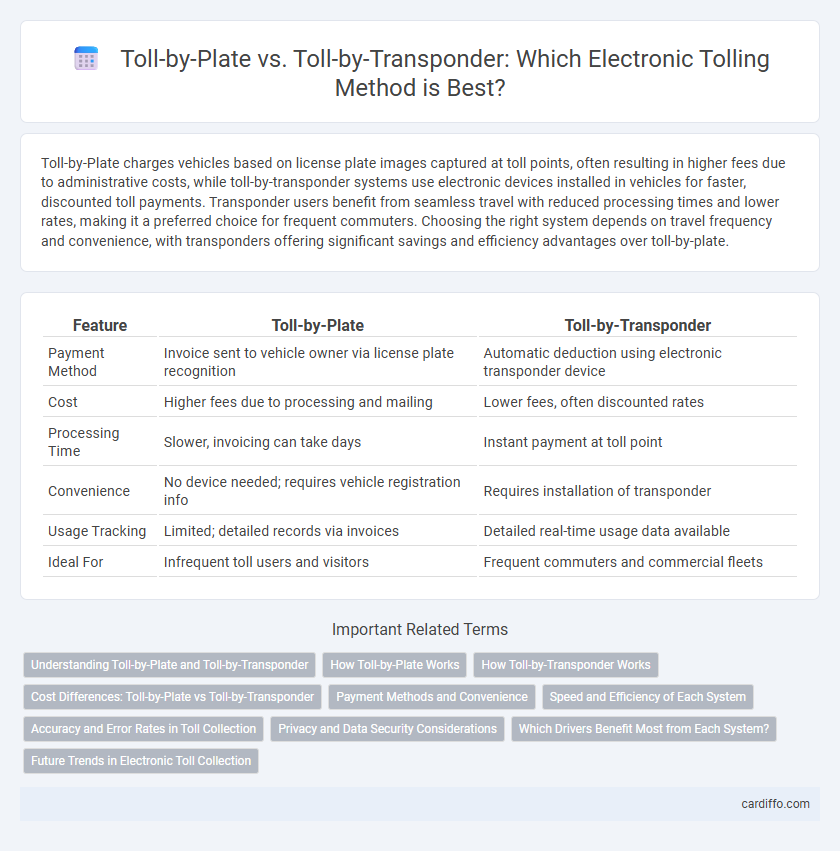Toll-by-Plate charges vehicles based on license plate images captured at toll points, often resulting in higher fees due to administrative costs, while toll-by-transponder systems use electronic devices installed in vehicles for faster, discounted toll payments. Transponder users benefit from seamless travel with reduced processing times and lower rates, making it a preferred choice for frequent commuters. Choosing the right system depends on travel frequency and convenience, with transponders offering significant savings and efficiency advantages over toll-by-plate.
Table of Comparison
| Feature | Toll-by-Plate | Toll-by-Transponder |
|---|---|---|
| Payment Method | Invoice sent to vehicle owner via license plate recognition | Automatic deduction using electronic transponder device |
| Cost | Higher fees due to processing and mailing | Lower fees, often discounted rates |
| Processing Time | Slower, invoicing can take days | Instant payment at toll point |
| Convenience | No device needed; requires vehicle registration info | Requires installation of transponder |
| Usage Tracking | Limited; detailed records via invoices | Detailed real-time usage data available |
| Ideal For | Infrequent toll users and visitors | Frequent commuters and commercial fleets |
Understanding Toll-by-Plate and Toll-by-Transponder
Toll-by-Plate uses a vehicle's license plate image captured by cameras for billing, eliminating the need for a physical device but often resulting in higher fees and delayed statements. Toll-by-Transponder employs a small electronic device mounted on the windshield, offering instant toll deductions, discounted rates, and real-time account management. Choosing between these systems affects cost, convenience, and payment speed for frequent highway and bridge users.
How Toll-by-Plate Works
Toll-by-Plate works by capturing a photograph of the vehicle's license plate as it passes through a toll point, automatically linking the image to the registered owner for billing purposes. This system eliminates the need for a transponder device, making it convenient for drivers without electronic tags. Charges are typically sent via mail or email, reflecting the toll amount plus any service fees for processing the license plate data.
How Toll-by-Transponder Works
Toll-by-Transponder operates using a small electronic device mounted on a vehicle's windshield that communicates with roadside toll sensors via radio frequency identification (RFID) technology. When a vehicle passes through a toll lane, the transponder transmits a unique identification signal to the toll system, enabling automatic and instantaneous toll deduction from a prepaid account. This method offers faster processing and reduced congestion compared to Toll-by-Plate, which relies on camera capture and manual billing based on license plate recognition.
Cost Differences: Toll-by-Plate vs Toll-by-Transponder
Toll-by-Plate typically incurs higher costs due to additional processing fees and billing charges, often ranging from 25% to 50% more than Toll-by-Transponder. Toll-by-Transponder users benefit from discounted toll rates and immediate electronic payments, reducing overall expenses. Choosing a transponder setup can save frequent travelers significant money compared to pay-by-mail options linked to Toll-by-Plate systems.
Payment Methods and Convenience
Toll-by-Plate charges are billed by capturing a vehicle's license plate image and sending the invoice by mail, offering convenience for drivers without transponders but generally incurring higher fees and delayed payment processing. Toll-by-Transponder uses a prepaid electronic device linked to the driver's account, enabling instant toll payments, discounted rates, and seamless travel through toll plazas without stopping. This method provides a more efficient and cost-effective solution, especially for frequent travelers seeking convenience and control over toll expenses.
Speed and Efficiency of Each System
Toll-by-Transponder systems offer faster transaction speeds, triggering toll payments instantly as vehicles pass, minimizing congestion and improving overall traffic flow. Toll-by-Plate relies on image processing and license plate recognition, which can introduce delays due to manual verification and billing, reducing efficiency during peak hours. The transponder system's real-time communication enables seamless toll collection, making it more effective for high-speed travel environments.
Accuracy and Error Rates in Toll Collection
Toll-by-Transponder systems demonstrate higher accuracy and lower error rates in toll collection due to real-time vehicle identification and seamless scanning technology. Toll-by-Plate systems rely on license plate recognition, which is prone to errors from poor image quality or obscured plates, resulting in increased misread tolls and billing disputes. Data from transportation agencies show error rates in Toll-by-Plate can be up to three times higher than those observed in transponder-based toll collection methods.
Privacy and Data Security Considerations
Toll-by-Plate systems capture and store license plate images linked to vehicle owners, raising concerns about potential misuse of personal data and extended retention periods. In contrast, Toll-by-Transponder relies on encrypted RFID signals with minimal personally identifiable information, offering enhanced privacy controls and reduced risk of unauthorized data access. Choosing Toll-by-Transponder can significantly mitigate privacy risks through secure, limited data transmission compared to the more vulnerable image-based Toll-by-Plate method.
Which Drivers Benefit Most from Each System?
Toll-by-Plate benefits infrequent drivers or occasional visitors by eliminating the need for a transponder and allowing payment through license plate recognition, though it often incurs higher fees. Toll-by-Transponder suits frequent commuters and commercial drivers who gain discounted toll rates and faster processing with electronic tags like E-ZPass. Selecting the optimal system depends on driving frequency, cost sensitivity, and convenience preferences.
Future Trends in Electronic Toll Collection
Future trends in electronic toll collection emphasize increased adoption of Toll-by-Plate systems due to their convenience and scalability without requiring physical devices. Advancements in high-resolution cameras and automated license plate recognition technology enhance accuracy and reduce operational costs compared to traditional Toll-by-Transponder methods. Integration with smart city infrastructure and real-time data analytics drives the evolution of seamless, multi-lane free-flow tolling systems, promoting efficient traffic management and user experience.
Toll-by-Plate vs Toll-by-Transponder Infographic

 cardiffo.com
cardiffo.com